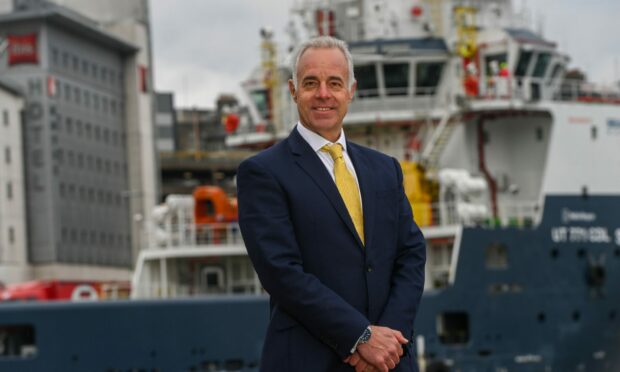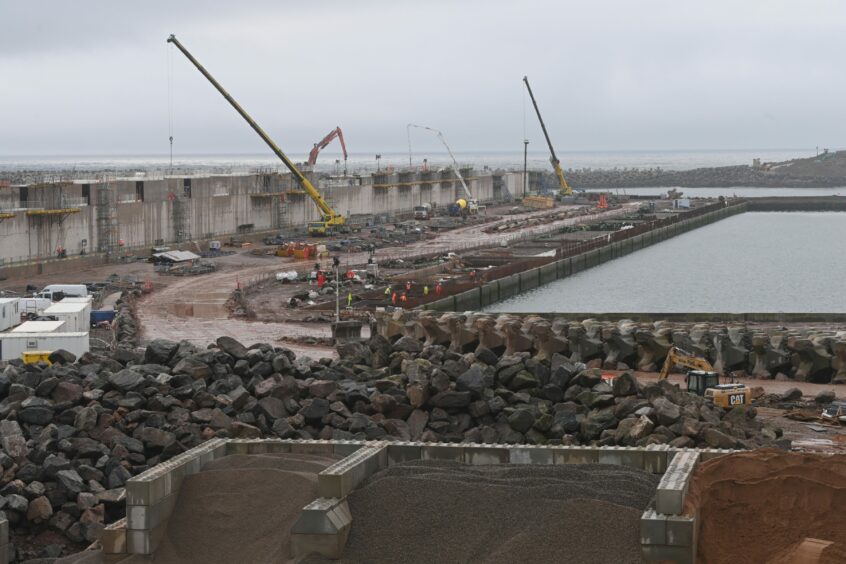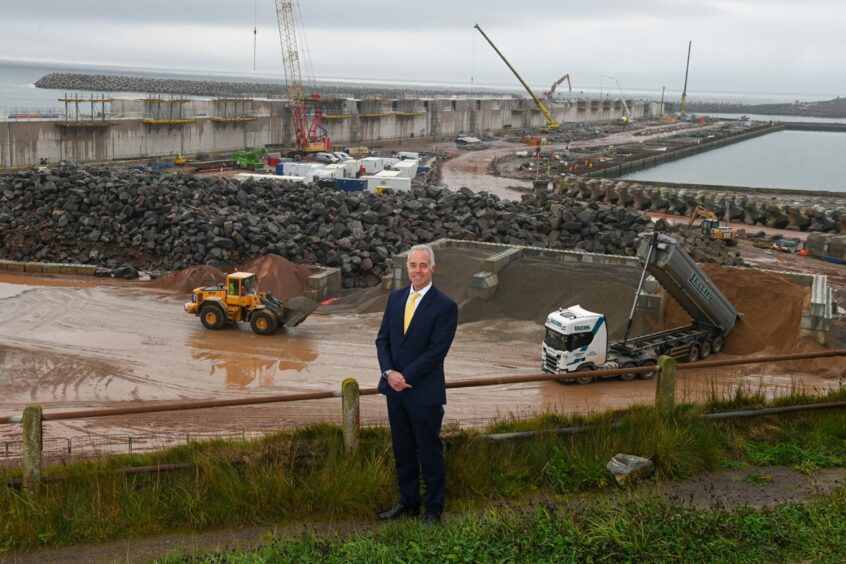It has been 18 long months of stormy seas for Aberdeen Harbour, but Bob Sanguinetti is confident the port and its £350million expansion project is well on its way to reaching safe haven.
The new chief executive of Aberdeen Harbour Board (AHB) has taken the helm of the UK’s oldest registered company at a critical time.
“It is one of the biggest, if not the biggest, marine construction infrastructure projects in the UK at the moment and the biggest by far a trust port like Aberdeen has undertaken,” he said, as he noted the scale of the achievement that is now emerging from the waters of Nigg Bay.
For example, the striking south breakwater – built using thousands of spiky, concrete accropodes which are manufactured on site – is now in place.
As it gets closer to completion, it is now more a land-based project as efforts focus on completing the 1.4km of quayside which will accommodate the “bigger, deeper, wider” vessels that are expected to dock.
With the development having survived the early departure of its main contractor and a global pandemic, Mr Sanguinetti sounds confident the South Harbour will have all it requires to be operational by October 2022.
Plain sailing? Not quite yet
Yet some challenges remain, he has acknowledged.
A few months before Mr Sanguinetti arrived, AHB chairman Alistair Mackenzie sounded the alarm that the funding to deliver some of the important aspects of the new harbour was at risk of running dry.
Mr Sanguinetti insisted the project is “running to budget” but that it currently faces price hikes in building materials as well as, like many, having suffered reduced income during Covid.
He said: “We have had to modify the project but not substantially and we will get there eventually.”
The South Harbour will still be on track for its initial “green port strategy” – with the aim of offering electric shore power for ships as well as offering capacity for future fuel requirements. But he still thinks there is a case for the government to cough up more, so he issued a plea:
“Aberdeen Harbour is at the forefront of the support to the offshore sector and has been for the last 50 years,” he said.
“It has amassed a huge amount of expertise in partnership with the big energy companies with the logistics supply chains in and around Aberdeen.
“It is extremely well placed to transfer those high skills and expertise from oil and gas into renewables as we go through the industry transition.
The plea is for both UK and Scottish governments to support Aberdeen and Aberdeen Harbour in particular so that we can continue leading the way in terms of energy transition in our aspiration to achieve net zero.”
“The plea is for both UK and Scottish governments to support Aberdeen and Aberdeen Harbour in particular so that we can continue playing that prominent role and leading the way in terms of energy transition in our aspiration to achieve net zero.”
Meanwhile, the north-east was overlooked in a £1billion competition to develop carbon capture and storage projects (CCUS) by the UK government, nor were there any rabbits pulled out of the Chancellor of the Exchequer’s hat for the harbour in the recent Autumn budget statement.
He said he was “disappointed and surprised” that the Acorn project, which would have galvanised the region’s shift away from fossil fuels, did not land nearby to the port.
But Mr Sanguinetti, who came from a 30-year career in the Royal Navy, remains unperturbed.
He has not ruled out the potential for further UK treasury funding. The harbour boss pointed to allocations for transport and clean-tech in the budget’s small print which chime with the harbour’s core plans.
“I am fairly confident that both Westminster and Holyrood understand the national importance of a hub like Aberdeen Harbour,” he said.
Green ports versus free ports
What he would like to see is clarity in the current impasse over Holyrood’s vision for green ports versus Westminster’s proposals for free ports.
AHB has joined forces with Peterhead Harbour, and both Aberdeen and Shire local authorities to win the designation whichever form hit takes.
He did not suggest preference, just a desire for a decision either way.
He said: “We are watching progress with close interest both on the UK front with free ports and on the Scottish Government front with green ports.
“In either case it is essential we see that detail sooner rather than later so we can move on and seize the opportunities that are presenting themselves as we go through the energy transition piece.”
Meanwhile, like many, his eyes are on the prize of the Scotwind leasing round which will determine the establishment of 15 major offshore windfarms in Scottish waters in a decision expected early next year.
“A lot of those wind farms will be directly off the coast of Aberdeen and the harbour will be perfectly placed to support the construction, the development, the servicing of those wind farms, not just in terms of the start of the project life but throughout the next 20, 30, 40 years of that lifespan,” he said.
He said the development of the Energy Transition Zone (ETZ) on land next to the South Harbour will be “fundamental” to the region’s economy and provide significant synergies for the harbour.
“Whether it is light manufacturing, assembly, design – all of which will generate high tech and highly skilled jobs for the community which has got to be a good thing for Aberdeenshire,” he said.
Being a good neighbour
He is also conscious of the importance of being a good neighbour to the residents of Torry, many of whom are concerned about the impact of both the harbour expansion and the ETZ.
Following his naval career, he took on the role of CEO of the Gibraltar Port Authority, where he was credited with delivering significant growth in vessel traffic in a port nestled closely with the local community.
“With my background in Royal Navy but also my job running the port of Gibraltar and also heading up the UK Chamber of Shipping, in all of them you deal with a wide range of stakeholders and you have to be aware of the interests and the agendas of different parties,” he said.
“You have to find common ground, you have to compromise. Because at the end of the day what we are doing here is not purely for the benefit of Aberdeen Harbour, it is for the community we live in.
“Yes there are challenges.
“We are in a community. We need to work with that community. We need to find a way forward that benefits economically and socially the environment we are in without inadvertently impacting negatively on the community.
“Whether it is access to and from the harbour, or emissions – all those things need to be addressed and resolved.”


